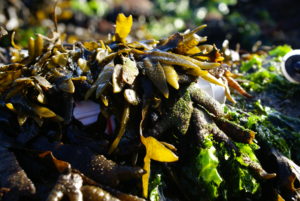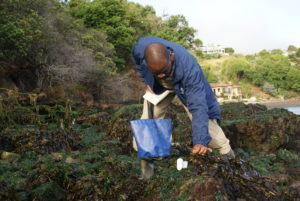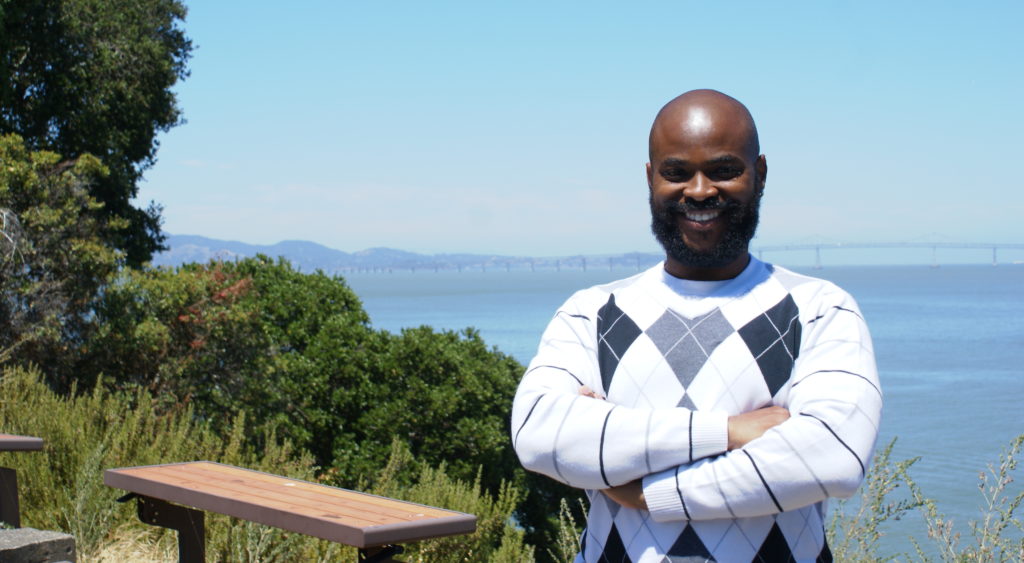by Alison Haigh
If there’s any constant in SERC research fellow Jason Thomas’ diverse career, it’s that he’s always looking for opportunities to learn something new. He’s a science teacher, and that’s one thing that brought him to education: It keeps him in a constant state of learning.
Originally, though, he wanted to be a doctor. After getting a bachelor’s in sociology and a post-baccalaureate in biology, he worked in a molecular lab analyzing octopus eyes, and then in a mosquito hatchery. He then got a medical doctorate—but after having trouble securing a residency, he found himself going back to school for a master’s in teaching.
“Once, someone called me ‘Graduation Jason’ because all I do is graduate,” Thomas joked. Now that he’s a science teacher at Browning High School in Long Beach, California, he’s helping his students graduate with the skills they need to pursue careers in STEM.
But even on his summer breaks, he’s still learning. This summer, the Smithsonian Environmental Research Center’s West Coast lab in Tiburon, California, hosted Thomas through the state’s STEM Teacher and Researcher (STAR) program. The program gives early-career science teachers authentic research opportunities. Now that he’s back at school in Long Beach, he’ll bring two summers of research experiences to inspire his students.
Life’s No Beach in the Intertidal Zone

Rockweed, a type of brown seaweed, covers rocks and a white experimental sensor in San Francisco Bay. Scientists think rockweed may help protect oysters and other animals from drying out during low tide. (Credit: Alison Haigh/SERC)
Thomas spent his last two summers clambering over slippery rocks and trudging across the mud flats of San Francisco Bay with SERC scientist Chela Zabin. His first summer, they surveyed for native oysters at restoration sites—but found only a single oyster. That got him thinking about what makes sites inviting for oysters. This summer, that thought led him to study the more conspicuous brown seaweed called rockweed.
Thomas and Zabin share a hunch that the brown seaweed might pack a positive ecological punch. That’s because life’s no beach in the intertidal zone. After the tide goes out, any marine life that can’t move into deeper water, like oysters, must endure drastic temperature swings and exposure to air for up to 12 hours. But the canopy of the rockweed could provide crucial protection for delicate organisms like oysters while the tide is out.
Trees play a similar role in forests by creating the right habitat for shrubs and shade-tolerant plants. Scientists know that other seaweeds can also do this—for example, giant kelp in kelp forests just off the California coastline. Thomas decided to investigate if there is a similar effect on Chaucy Point, at the Estuary and Ocean Science Center where SERC has its California base.

Jason Thomas places temperature and humidity sensors beneath rockweed on a beach in San Francisco Bay. (Credit: Alison Haigh)
On three different days, he placed four temperature and humidity sensors on the beach. Two sat under canopies of seaweed, and two on bare rock. While the beach was exposed at low tide, the sensors collected data. The experiment showed the temperature and humidity that oysters would experience at low tide, when they are most at risk of drying out or suffering heat stress.
Thomas guessed that rockweed would keep his sensors cool. His data proved him right. On average, the environment under the rockweed was consistently cooler and moister than outside of it. This meant it could protect animals underneath from rapid changes in temperature or from drying out. It could also mean that rockweed might play an important part in restoring native oysters around San Francisco Bay, and in other intertidal ecosystems.
Making Science More Colorful
Thomas got the results he expected, but that didn’t make the science any less exciting for him. And his excitement extends to his students. He sees that bringing experiential learning into the classroom helps his students build the skills they need to pursue degrees and careers in science.
“I want them to have the skills to do what I did: investigate what they are curious about,” Thomas said. “That’s so much more authentic than just handing them a lab and having them fill out the blanks.”
But on another level, empowering the students to pursue those opportunities at all is just as important as learning scientific skills. Many of his students come from low-income households without family members who went to college. Thomas sees students struggle without role models at home who are knowledgeable about careers in science.
The majority of his students are also Latino, Latina or black. While he can relate to their experiences, he is still concerned about how few STEM educators are from minority backgrounds.
“As a teacher, you go to staff meetings, and you look around the room, you might see people of color—but so few are in STEM,” Thomas says. “It makes you wonder, okay, where is everybody? Because you don’t know—did they not apply? Did they not qualify? Did they not get picked? Nobody tells you why there aren’t more people that look like you in a program. ”
Thomas sees mentorship as key to inspiring the next generation of diverse scientists, by making students of color feel comfortable and included enough to apply to STEM programs.
“You can’t reach everybody, but if you can reach one or two, you’ve done your job,” Thomas says. “I’m sure it’s not just me. It’s coming from all the teachers—but I feel like I’ve had a hand in it. I feel like that’s a success.”


